
后台服务是 JSON-RPC 风格的,所以 Scenario 都是这样的
Scenario: login successful
When I set request body from "features/examples/login.json”
When I send a POST request to "/app_api/session/authenticate/“
Then the response status should be "200"
Then the JSON response should follow "features/schemas/login_response.schema.json"
Then the JSON response should have key "$.result.username" with "cucumbertest”
HTML 报告是这样的

项目目录结构是这样的
.
└── features
├── examples
│ └── login.json
├── schemas
│ └── login_response.schema.json
├── step_definitions
│ └── setp.rb
├── support
│ └── env.rb
└── user.feature
现在想把 features/examples/login.json 和 features/schemas/login_response.schema.json 这部分加上超链接,点击后显示相应文件内容,把
<span class="param">features/examples/login.json</span>
改为
<a href="features/examples/login.json" target="_blank">features/examples/login.json</a>
在源码里搜索span class="param”,发现拼接这部分 HTML 的是 lib/cucumber/formatter/html.rb 文件里的 build_step 方法
在 features/support 目录下新建 html_with_link.rb 文件,输入
require 'cucumber/formatter/html'
module Cucumber
module Formatter
class HtmlWithLink < Html
def build_step(keyword, step_match, status)
# step_name = step_match.format_args(lambda{|param| %{<span class="param">#{param}</span>}})
# 加上<a>标签
step_name = step_match.format_args(lambda{|param| %{<span class="param"><a href="#{param}" target="_blank">#{param}</a></span>}})
@builder.div(:class => 'step_name') do |div|
@builder.span(keyword, :class => 'keyword')
@builder.span(:class => 'step val') do |name|
# name << h(step_name).gsub(/<span class="(.*?)">/, '<span class="\1">').gsub(/<\/span>/, '</span>’)
# 包含 '.json’ 部分的 param 做 UrlEncode ,不包含的删去<a>标签
if step_name.include? '.json'
name << h(step_name).gsub(/<span class="(.*?)">/, '<span class="\1">').gsub(/<\/span>/, '</span>').gsub(/<a href="(.*?)" target="_blank">/, '<a href="\1" target="_blank">').gsub(/<\/a>/, '</a>')
else
name << h(step_name).gsub(/<span class="(.*?)">/, '<span class="\1">').gsub(/<\/span>/, '</span>').gsub(/<a href="(.*?)" target="_blank">/, '').gsub(/<\/a>/, '')
end
end
end
step_file = step_match.file_colon_line
step_file.gsub(/^([^:]*\.rb):(\d*)/) do
if ENV['TM_PROJECT_DIRECTORY']
step_file = "<a href=\"txmt://open?url=file://#{File.expand_path($1)}&line=#{$2}\">#{$1}:#{$2}</a> "
end
end
@builder.div(:class => 'step_file') do |div|
@builder.span do
@builder << step_file
end
end
end
end
end
end
执行cucumber -f Cucumber::Formatter::HtmlWithLink -o result.html,新的报告里有链接了

另一种改法
require 'cucumber/formatter/html'
module Cucumber
module Formatter
class HtmlWithLink < Html
def inline_js_content
<<-EOF
SCENARIOS = "h3[id^='scenario_'],h3[id^=background_]";
$(document).ready(function() {
$(SCENARIOS).css('cursor', 'pointer');
$(SCENARIOS).click(function() {
$(this).siblings().toggle(250);
});
$("#collapser").css('cursor', 'pointer');
$("#collapser").click(function() {
$(SCENARIOS).siblings().hide();
});
$("#expander").css('cursor', 'pointer');
$("#expander").click(function() {
$(SCENARIOS).siblings().show();
});
// 下面是新加的
$("span.param").each(function(index,element){
if ($(element).text().indexOf(".json") > 0) {
text = $(element).text()
href = "<a>" + text + "</a>"
$(element).html(href)
$(element).children("a").attr({
"href" : text,
"target" : "_blank"
});
}
});
// 上面是新加的
})
function moveProgressBar(percentDone) {
$("cucumber-header").css('width', percentDone +"%");
}
function makeRed(element_id) {
$('#'+element_id).css('background', '#C40D0D');
$('#'+element_id).css('color', '#FFFFFF');
}
function makeYellow(element_id) {
$('#'+element_id).css('background', '#FAF834');
$('#'+element_id).css('color', '#000000');
}
EOF
end
end
end
end
参考文章:Is it possible to generate cucumber html reports with only scenario titles with out steps?
